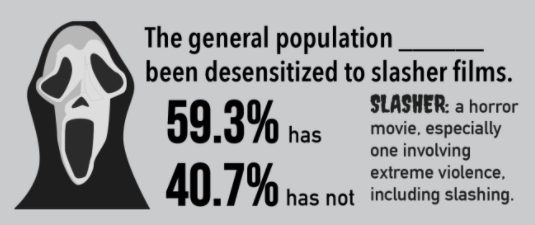Are people “scream”-ing less due to the rise of horror films?

BLOT GRAPHIC BY DANI McLAUGHLIN
A survey of 54 students from Feb. 3 to Feb. 10.
March 12, 2021
Sidney runs away from the killer, drenched in blood. Without her friends, she is the lone target. The killer puts a knife to her throat and says, “Now Sid, don’t you blame the movies. Movies don’t create psychos. Movies make psychos more creative!”
“Scream” by Wes Craven is the perfect example of a film that incorporates slasher violence and the observable effects of horror movies on society. Throughout the movie, teens become desensitized to the idea of violence. This means when something is done or shown repeatedly, it can cause lesser reactions.
Watching Alfred Hitchcock’s 1960 masterpiece “Psycho” or John Carpenter’s 1978 horror classic “Halloween” may cause this anomaly. This would be due to their violent nature and the scenes shown throughout. Desensitization can also be seen in other media, such as video games. This does not mean we need to stop watching these movies or playing these games, but it does mean we should learn the subconscious effects they are having on the mind.
Junior Kara Petrosino of Colts Neck explained that horror movies may show violence, but she doesn’t believe that they are the cause of violence. “I wouldn’t really say that slasher films desensitize viewers to violence,” Petrosino said. “I’m able to separate the things that are fiction and the things that are real in my mind.”
Slasher films cause a wide range of emotions such as stress, anxiety and fear, yet the repeated actions of watching violent cinema cause fewer effects the next time this genre of film is viewed.
Desensitization is not always drastic, yet in slasher films it is prevalent. This is one of the reasons age ratings such as R, PG-13 and PG exist. The more violent the movie, the more likely it will be labeled with an “R” rating. Many countries have stricter ratings than the United States, in fear that the viewing of violence will not only affect children but adults as well.
For example, Sweden limits the distribution of movies with excessive violence. While Sweden does see less crime compared to the U.S., there is no distinction that horror movies play a part in the immense decrease in violent crime.
The scapegoat that horror movies cause violence, in the media, is a misconstrued statement that leaves many of the problems at hand unhandled.
Petrosino suggests that violence in films do not specifically cause violence in real-life.
“The more slashers you watch, you may become more accustomed to the
types of violence portrayed in those films, but I don’t think that necessarily
carries over to violence in real life,” Petrosino said.



